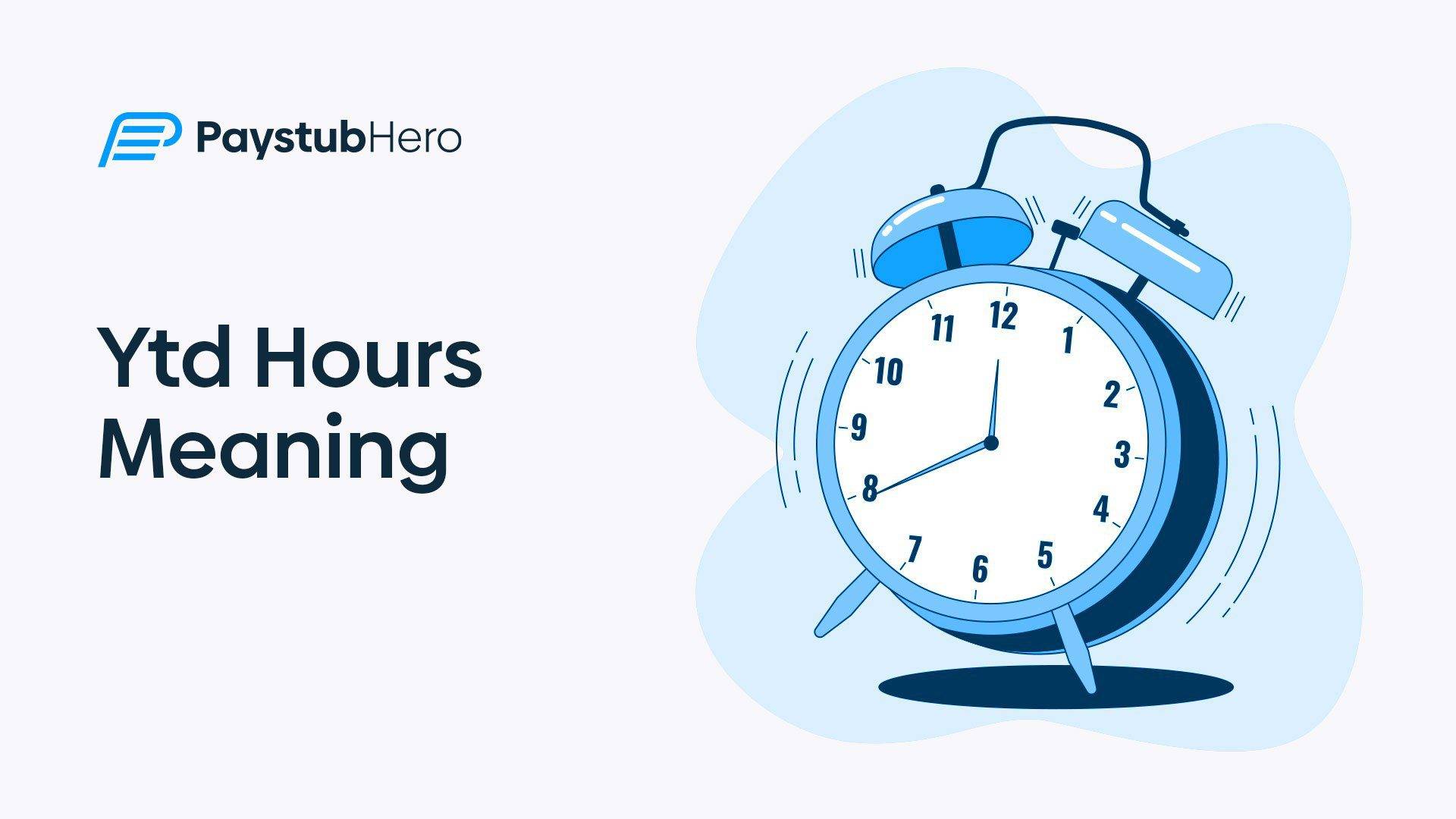YTD stands for “Year-to-Date.”
YTD Hours means the total hours you’ve worked since January 1 of the current year.
It includes regular hours, overtime, paid time off, and sometimes unpaid leave. Actually, it depends on how your employer tracks it. It gives you a running total of your labor up to the most recent pay period.
This number resets every January. It’s a way to track your hours over the course of the year.
Benefits?
Your YTD Hours help you:
⦿ Track how many hours you’ve worked overall
⦿ Confirm you’re being paid correctly
⦿ Catch payroll errors early
⦿ See how close you are to full-time or part-time thresholds
⦿ Understand how much time you’ve spent on overtime or PTO
If you’re paid hourly, your YTD Hours directly impact your total YTD earnings. Even if you’re salaried, these hours still matter for compliance, benefits, and labor reporting.
Related: Paycheck Stub Abbreviations
Where to Find YTD Hours on Your Pay Stub
Not every pay stub shows YTD Hours, but many do. It’s often listed near the breakdown of your hours and pay for the current period.
Look for a column labeled “YTD” next to your hours. It might look like this:
|
Description |
Current Hours |
YTD Hours |
|
Regular Hours |
40 |
1,200 |
|
Overtime Hours |
5 |
130 |
|
PTO |
8 |
56 |
If you don’t see it, ask your employer or payroll provider. Some pay stubs don’t display YTD Hours by default, but the info is usually tracked behind the scenes.
What’s Included in YTD Hours?
Some hours carry more weight than others. Let’s take a closer look:
➡ Regular Hours
This is your standard, scheduled work time. Usually 40 hours per week for full-time roles.
➡ Overtime Hours
Any hours over 40 in a week (for most jobs) count as overtime. These are tracked separately and may be paid at time and a half.
➡ Paid Time Off (PTO)
If you used vacation days, sick time, or personal time, those hours are usually included in your YTD total.
➡ Holidays
Some employers include paid holidays in your YTD Hours, others don’t. It depends on how time is recorded.
➡ Unpaid Time Off
Typically not included. But if it’s logged in your time system, it might still show in your total depending on how reports are pulled.
How Employers Use YTD Hours
Employers track YTD Hours for several reasons:
⦿ Payroll calculations: To ensure accurate pay, especially for hourly workers
⦿ Benefits eligibility: To confirm if you meet the minimum hour requirement
⦿ Compliance: For labor laws, overtime rules, and reporting
⦿ Performance tracking: Some companies link hours worked to goals or productivity
Example: YTD Hours in Action
Let’s say you started working January 1 and your company pays you every two weeks.
Here’s a sample snapshot from your 10th paycheck of the year:
|
Pay Period |
Regular |
Overtime |
PTO |
YTD Regular |
YTD OT |
YTD PTO |
|
Mar 1 – Mar 14 |
80 |
2 |
0 |
800 |
20 |
16 |
You can see:
⦿ You worked 80 hours this period
⦿ You had 2 hours of OT
⦿ You’ve worked 800 regular hours so far this year
⦿ 20 total OT hours
⦿ 16 hours of PTO taken
This gives you a clear view of your work history and how it’s affecting your earnings.
How to Use YTD Hours for Budgeting and Planning
YTD Hours aren’t just for payroll people. Here’s how you can use them:
1. Estimate Annual Income
If you know your hourly rate and YTD Hours, you can estimate what you’ll make this year.
Example: Hourly Rate: $20 YTD Hours: 1,250 Estimated Earnings: $25,000 so far
Multiply your average weekly hours by the weeks left in the year to project future earnings.
2. Track Overtime
Compare current period OT to your YTD OT. Are you getting more or less? Are you being fairly compensated?
3. Watch Your PTO Balance
If your YTD PTO usage is rising fast, you might want to slow down or plan ahead. It helps prevent unpaid time off later.
Questions to Ask If YTD Hours Look Off
If your YTD Hours seem low or high, here’s what to check:
⦿ Are any pay periods missing?
⦿ Were hours coded incorrectly (e.g., OT as regular)?
⦿ Did you take unpaid time off that wasn’t logged?
⦿ Are holiday hours recorded?
⦿ Is your start date mid-year? YTD only counts from then on.
Ask payroll or HR for clarification. Errors happen, but they’re fixable when caught early.
How YTD Hours Affect Taxes and Deductions
Your hours worked don’t directly affect how much tax you pay. Your total earnings do. But since YTD Hours help calculate those earnings, they play an indirect role.
Here’s how:
⦿ More hours = more earnings
⦿ More earnings = higher tax withholding
⦿ Accurate hours = correct tax and benefit deductions
If hours are underreported, your pay and taxes could be wrong. That’s why keeping an eye on your YTD Hours helps.
How to Calculate YTD Hours Yourself
If your pay stub doesn’t show YTD Hours, you can still figure it out. You just need your pay schedule and the hours worked each period.
Step-by-step:
⦿ Count how many pay periods you’ve had since January 1.
⦿ Add up the hours you worked in each pay period.
⦿ Include overtime and PTO if your company normally counts those.
Illustration:
Say you’re paid biweekly (every two weeks), and you’ve received 10 paychecks so far.
⦿ Regular Hours per period: 80
⦿ Overtime: 2 per period (on average)
⦿ PTO used total: 16 hours
YTD Hours = (80 × 10) + (2 × 10) + 16 = 800 + 20 + 16 = 836 hours
This total helps you compare against your pay stub or employer records.
Can You Dispute Incorrect YTD Hours?
Yes, and you should if you notice something off.
Here’s how to handle it:
⦿ Start with your time records: Compare your personal timesheets or clock-ins.
⦿ Bring up specifics: “My Jan 12-26 paycheck shows 75 hours, but I worked 80.”
⦿ Email HR or payroll: Include screenshots or summaries. Be polite but clear.
Most payroll issues are just mistakes, not intentional. The sooner you flag them, the easier they are to fix.
What If You Changed Jobs This Year?
YTD Hours only apply to your current employer. If you started mid-year or switched jobs, your YTD will reflect only the hours worked with your current company since your start date.
So if you started a new job on April 1:
⦿ YTD Hours = Total hours worked from April 1 to now
⦿ Your previous employer’s hours won’t carry over
This is important for tracking total income across jobs or understanding W-2 forms at tax time.
How YTD Hours Tie Into Benefits and Eligibility
Some benefits require a minimum number of hours worked each year. YTD Hours help determine if you qualify.
Common thresholds:
⦿ Healthcare eligibility: Often 30+ hours/week on average
⦿ 401(k) or retirement plans: May require 1,000+ hours annually
⦿ Vacation accruals: Some companies increase PTO after a certain number of hours
If you’re near the cutoff, checking your YTD Hours can help you plan ahead, especially if you’re part-time or newly hired.
Extra Tip: Use YTD Hours to Plan Time Off
Many employees don’t realize they can use their YTD Hours to project future time off.
Let’s say your employer gives:
⦿ 1 hour of PTO per 30 hours worked
If you’ve worked 900 hours so far:
⦿ PTO Earned = 900 ÷ 30 = 30 hours
This helps you see how much time you’ve banked, and how much more you’ll earn if you keep your current pace.
You can use this to:
⦿ Schedule vacations
⦿ Avoid unpaid absences
⦿ Make sure you use your benefits before they expire
How PaystubHero Can Help You Track YTD Hours
If your pay stub doesn’t make things easy, PaystubHero can.
Our platform lets you:
➼ Create clean pay stubs with YTD Hours included
➼ Customize what hours are shown (regular, OT, PTO)
➼ Track your YTD totals across multiple jobs or pay periods
➼ Catch missing hours or errors before they become a problem
Whether you’re self-employed, a freelancer, or just want more clarity, PaystubHero gives you control over your payroll records.
FAQs
Here are some common questions about YTD hours.
No. Breaks like lunch or unpaid time aren’t included. Only logged, compensable time is counted unless your employer tracks it differently.
If it’s paid leave (like PTO or FMLA), it may still be included. If it’s unpaid, your YTD Hours usually won’t increase during that time.
Sometimes. Paid holidays may be added if they’re coded as work hours. Check your employer’s time tracking policy.




